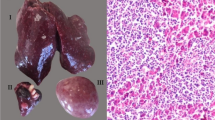Abstract
Domesticated fowls, pigeons and turkey birds were screened for avipoxvirus infection from different areas in Jammu region. Based on typical pox lesions the overall occurrence in fowl was found to be 18.52%, 17.03% in pigeons and 57.14% in turkeys. Mortality recorded in chicks was 41.96%, 45.36% in squabs, 100% in poults, and 20.00% in adult turkeys. Both cutaneous and diphtheritic forms of the disease was observed of which the latter was particularly prevalent in young birds. One sample of putative fowlpox virus (FWPV) from skin lesions of a fowl, and two samples of putative pigeonpox virus (PGPV) from skin and diphtheritic lesions each were inoculated on chorio-allantoic membrane (CAM) of 10–12 days old chicken embryonated eggs. A confirmatory diagnosis was made by PCR amplification of a highly conserved P4b gene locus detected in tissue samples from skin, diphtheritic membrane and virus inoculated CAM yielding a predicted 578 bp product. Phylogenetic analysis based on the same P4b gene locus revealed FWPV and turkeypox virus (TKPV) to be 99% related and belonging to clade 1, while PGPV was found to belong to clade 2. All three isolates illustrate considerable heterogeneity within the conserved P4b gene locus. The study indicates that the closely related FWPV and TKPV isolates may have the potential of cross infection between fowls and turkeys and therefore cross transmission studies are suggested.


Similar content being viewed by others
References
Ahamad DB, Punniamurthy N, Sivaseelan S, Ranganathan V. Pathomorphology and ethno-veterinary herbal intervention in an outbreak of turkey pox. Indian J Vet Pathol. 2013;37(1):18–21.
Ahamad DB, Nashiruddullah N, Azmi S, Qureshi SA, Khan A, Koul A, Katoch R, Taku AK. An outbreak of Turkey Pox in Jammu region. In: National symposium on pathobiology of Poultry and Laboratory Animal Diseases, held at Veterinary College and Research Institute, Namakkal, Tamil Nadu from 5–6 March 2010. Abstract No. 6.1.26; 2010.
Biswas SK, Jana C, Chand K, Rehman W, Mondal B. Detection of fowlpox virus integrated with reticuloendotheliosis virus sequences from an outbreak in backyard chickens in India. Vet Ital. 2011;47(2):147–53.
Cunningham CH. A laboratory guide in virology. 7th ed. Minneapolis: Burgess Publishing Co.; 1973.
Das P, Joardar SN, Samanta I, Das PK, Jana C, Isore DP, Sadhukhan TK. Isolation and molecular confirmation of Avipoxvirus in backyard chicken in West Bengal. Indian J Comp Microbiol Immunol Infect Dis. 2013;34(1):8–10.
Davidson WR, Kellogg FE, Doster GL. An epornitic of avian pox in wild Bobwhite quail. J Wildlife Dis. 1980;16:293–8.
Dhanesar NS, Sharma SN, Malik BS. Fowlpox outbreaks in vaccinated flocks and isolation of virus strains. Indian Vet Med J. 1980;4:144–8.
Forrester DJ, Spalding MG. Parasites and diseases of wild birds in Florida. Gainesville: University Press of Florida; 2003.
Garg SK, Joshi HC, Shukla HC. Vaccination failure in fowlpox. Indian J Vet Med. 1984;4:60–1.
Jarmin S, Manvell R, Gough RE, Laidlaw SM, Skinner MA. Avipoxvirus phylogenetics: identification of a PCR length polymorphism that discriminates between the two major clades. J Gen Virol. 2006;87:2191–201.
Jenkins CD, Temple SA, van Riper III C, Hansen WR. Disease related aspects of conserving the endangered Hawaiian Crow. In: Cooper JE (ed) Disease and management of threatened bird populations. ICBP technical publication series no. 10, Cambridge, England; 1989, p. 77–87.
Joshi RK, Shakya S, Gupta N. Isolation of fowl pox virus from fowl pox vaccinated layer flock. Indian J Comp Microbiol Immunol Infect Dis. 1995;16:139–40.
Lee LH, Lee KH. Application of the polymerase chain reaction for the diagnosis of fowl poxvirus infection. J Virol Methods. 1997;63:113–9.
Luschow D, Hoffmann T, Hafez HM. Differentiation of avian poxvirus strains on the basis of nucleotide sequences of 4b gene fragment. Avian Dis. 2004;48:453–62.
Mehmood S. Pathological conditions affecting the domestic pigeons (Columba livia) in Jammu. M.V.Sc. thesis, Sher-e-Kashmir University of Agricultural Sciences and Technology-Jammu, Jammu, India; 2017.
Okwor EC, Eze DC, Chah KF. Recurring outbreaks of Fowl Pox in a poultry farm in Nsukka, Southeast Nigeria. IOSR J Agric Vet Sci. 2014;7:104–8.
Pathak N. Prevalence, pathology and molecular diagnosis of pox in domestic birds. Ph.D. thesis submitted to Assam Agricultural University, Khanapara, Guwahati, India; 2016.
Pawar RM, Bhusan SS, Poornachandar A, Lakshmikantan U, Shivaji S. Avian pox infection in different wild birds in India. Eur J Wildl Res. 2011;57:785–93.
Singh A, Dash BB, Kataria JM, Dandapat S, Dhama K. Characterisation of an Indian isolate of turkey pox virus. Indian J Comp Microbiol Immunol Infect Dis. 2003;24(2):149–52.
Tripathy DN, Reed WM. Pox. In: Saif YM, Barnes HJ, Glisson JR, Fadly AM, McDougald LR, Swayne SE, editors. Diseases of poultry, 11th edn. Iowa State Press, Ames; 2003; p. 253–269.
van Riper III C, Forrester DJ. Fowl Pox. In: Thomas NJ, Hunter DB, Atkinson CT, editors. Infectious diseases of wild birds. Blackwell Publishing; 2008. p. 131–176.
Author information
Authors and Affiliations
Corresponding author
Additional information
Publisher's Note
Springer Nature remains neutral with regard to jurisdictional claims in published maps and institutional affiliations.
Electronic supplementary material
Below is the link to the electronic supplementary material.
Rights and permissions
About this article
Cite this article
Sharma, B., Nashiruddullah, N., Bhat, M.A. et al. Occurrence and phylogenetic analysis of avipoxvirus isolated from birds around Jammu. VirusDis. 30, 288–293 (2019). https://doi.org/10.1007/s13337-018-00507-0
Received:
Accepted:
Published:
Issue Date:
DOI: https://doi.org/10.1007/s13337-018-00507-0




